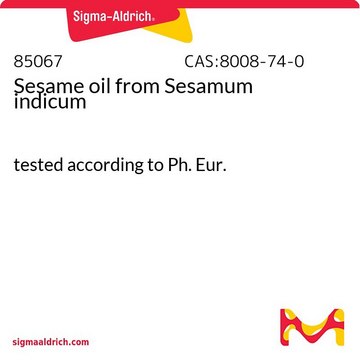88597
Hydrogen peroxide solution
3%, suitable for microbiology
Synonym(s):
Catalase Test, Catalase Test, H2O2
About This Item
Recommended Products
Agency
according to GB 4789.30-2016
according to ISO 10272-1:2017
according to ISO 10272-2:2017
according to ISO 11290-1:2017
according to ISO 11290-2:2017
Quality Level
vapor pressure
23.3 mmHg ( 30 °C)
Assay
2.8-3.2% (redox titration)
form
solution
shelf life
limited shelf life, expiry date on the label
storage condition
protect from light
concentration
1-5%
technique(s)
microbe id | specific enzyme detection: suitable
color
colorless
pH
6-8 (25 °C)
mp
0.0 °C
density
1.000 g/cm3
application(s)
clinical testing
environmental
food and beverages
veterinary
microbiology
suitability
Pneumococcus spp.
Staphylococcus spp.
bacteria
SMILES string
OO
InChI
1S/H2O2/c1-2/h1-2H
InChI key
MHAJPDPJQMAIIY-UHFFFAOYSA-N
Looking for similar products? Visit Product Comparison Guide
General description
Application
- Disinfectant: Hydrogen peroxide can be used as a disinfectant for surfaces, materials, and equipment in microbiology labs. When applied to surfaces, hydrogen peroxide reacts with organic materials, such as bacteria and fungi, and destroys them through oxidation.
- Sterilization: Hydrogen peroxide is often used in sterilization procedures in microbiology, especially in the pharmaceutical and medical industries. It effectively kills spores that are resistant to many other types of disinfectants.
- Microbial detection: Hydrogen peroxide can be used to detect catalase activity in bacteria, making it useful in microbial identification and differentiation. The species of bacteria may be distinguished based on their ability to catalyze the breakdown of hydrogen peroxide.
Storage Class Code
12 - Non Combustible Liquids
WGK
WGK 1
Flash Point(F)
Not applicable
Flash Point(C)
Not applicable
Personal Protective Equipment
Choose from one of the most recent versions:
Already Own This Product?
Find documentation for the products that you have recently purchased in the Document Library.
Articles
On the Trail of Campylobacter
Chromogenic media enable the selective detection of S. aureus, which produce bluish-green colonies that are clearly differentiated from other species.
For microbiologists the most fundamental stain was developed in 1884 by the Danish bacteriologist Hans Christian Gram.
Sigma-Aldrich.com presents an article concerning Differentiation of Escherichia coli from coliforms.
Our team of scientists has experience in all areas of research including Life Science, Material Science, Chemical Synthesis, Chromatography, Analytical and many others.
Contact Technical Service



